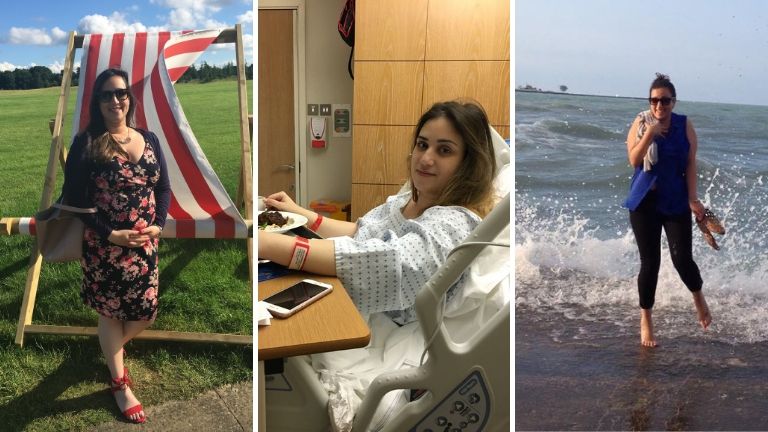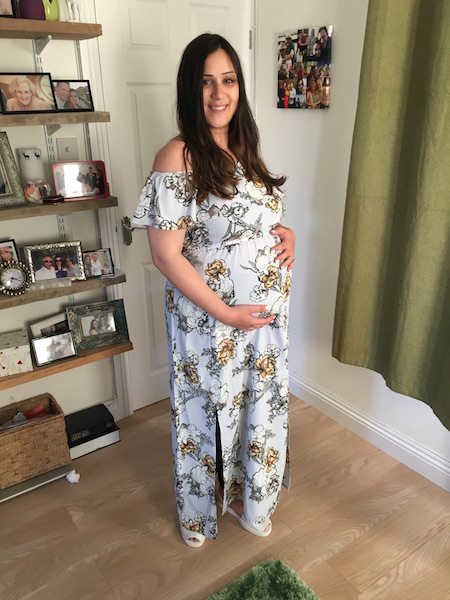She is a journalist, wife and mother but Punteha van Terheyden has also carried a terrible secret for almost a decade – painkiller addiction
Last month, the UK was declared in opiate crisis, with deaths from prescription drugs like morphine, codeine and tramadol having risen by 20 per cent since 2011, and a boom in availability of these medicines by 110 per cent in the last decade.
The results were collated by the Organisation for Economic Co-Operation, which aims to foster well-being for all. Apt, because addicts aren’t just found on the street, or in squats.
Addiction doesn’t discriminate and I know better than most, because it happened to me.
Journalist, wife, mother, addict
I’m a successful journalist, have a wonderful husband, an amazing daughter, my own home and financial independence, and still, I became dependant on opiates.
It began in August 2010, on the first day of my dream job as a feature writer on a women’s weekly magazine. I’d grafted for years to get myself here, so why was I despairing?
Well, pain.
Crippling, never-ending agony. A white-hot poker in my pelvis, radiating misery across my back and down my leg. Every MRI, pelvic scan and blood test was normal. Doctors had no idea what was wrong.
My 10-day periods were hell, leaving me nauseous, feverish and weak. Sex hurt, sitting was unbearable and going to the loo was horrible.
The cause was severe endometriosis but would go undiagnosed for years.
The prescription that started it all
I tried Pilates, acupuncture, physio, even had therapy but nothing helped. My GP did the humane thing and prescribed tramadol, a powerful painkiller derived from the opium poppy – the same plant as heroin – when lesser drugs failed.
It was no surprise that tramadol was hugely effective. The GP was right to help and I’m grateful people like me who need powerful pain relief can access it.
But he failed to tell me just how addictive it is.
When you take tramadol or codeine, a very similar drug, the liver breaks it down into morphine – the potency varying from person to person. Alarmingly, it takes only three days for someone to get hooked.
Despite this risk, GPs in Britain staggeringly hand out 2700 opiate prescriptions an hour. You can even walk into a pharmacy and buy codeine for a few pounds without a prescription.
Drugs like Solpadeine, Syndol, and Paracodol and Codis contain 8mg of codeine, or it’s quicker-acting, shorter-lasting cousin, di-hydracodeine. These are codeine combined with paracetamol, ibuprofen or caffeine, sometimes all three. Some are even available to order online, delivered straight to your door.
Over-the-counter opiates are brilliant when you have tooth ache and the dentist is fully booked, your period pain is horrendous, or your migraine is blinding.
But there is a reason opiates are known as ‘gateway’ drugs and have been banned without prescription in countries like America and Australia.
Developing a tolerance to the drugs
Opiate dependency can lead to more serious drugs as the body’s cells adapt to functioning on it, leading the user to need more frequent and bigger doses. Addicts also yearn for that ‘high,’ causing them to seek a more potent chemical euphoria.
In the beginning, my pills worked within 20 minutes. As my tolerance increased, it took an hour.
I didn’t realise at the time, but I anticipated that blissful moment opiate warmth spread through my veins, wiping pain away like magic
My GP put tramadol on repeat in 2010 without further review. That practice has since changed.
Still, I only took tramadol when I really needed it. It did however, become my safety net. I kept a pack in my bags, rooms, desk, and took them whenever my pain flared up.
My career made that hard to avoid. I commuted four hours a day to London and back, leaving my home in Surrey at 6:20am. As my endometriosis progressed, so too did my self-medicating.
Each morning on the train into work, I knocked back two tramadol and two ibuprofen as the pain I felt made the process of getting up, showered and walking to the station excruciating.
The same combination followed at lunch time after a few hours at my desk left me in a cold sweat, then again on the train home and again before bed.
Actually, and somewhat surprisingly, I was within so-called safety limits on everything I was taking except the Ibuprofen, of which I was taking four doses of instead of three. This prolonged ibuprofen use has left me with a persistent reflux problem so I have heartburn a lot and cannot touch Non-Steroidal Anti-Inflammatory Drugs (NSAIDs) like that anymore.
I was pretty relaxed about combining opiates with alcohol, which, by the way, you absolutely shouldn’t do. But if I wanted to join my new colleagues on nights out when my tolerance had finished somewhere around 11am, I had no choice.
Booze amplified the tramadol’s potency. I didn’t mind. It felt amazing to be pain free for a few hours.
Taking 26 tablets daily
Eventually, by summer 2011, I was taking eight tramadol, eight paracetamol, 6-8 high-dose anti-inflammatories and two pills to protect my stomach lining daily.
It was extreme, but so was my illness. For me, the choice was either opiates or quit my job, sign on and stay in bed.
When my endometriosis was finally diagnosed in November 2011, I had keyhole surgery to laser away as much of the disease as possible and free my left ovary, which was trapped in a mangle of adhesions (thick bands of scarring).
My pain drastically reduced, I stopped taking all the tablets eight weeks later and returned to work.
Almost immediately after I stopped, I came down with a nasty ‘flu’. I put it down to the strain of my post-op recovery, and grief from a bereavement.
My maternal Aunt Elina died at aged just 51 after breast cancer metastasised to her liver and bone marrow. It was awful, painful and left three young kids – my cousins – behind.
The whole family including myself were traumatised, devastated, despairing. I wanted to be strong for my mum but I was grieving terribly myself. I was so close to my aunt and on top of my very painful physical recovery from my operation, and the recent break up of a long-term relationship, everything felt unbearably hard for me.
That’s why I thought the flu-like effects I was experiencing were just a symptom of how run down I was – I had really been through the ringer and assumed my body was just kind of breaking down from the stress.
I tucked tissues under my reading glasses to stem my streaming eyes, loaded up on paracetamol and carried on. Everybody in the office laughed at the state of me, and so did I.
The ‘virus’ that wouldn’t shift
A month later, the virus just wouldn’t shift. I lost my voice, had night sweats, jittering limbs, joint pain, diarrhoea, nausea, fever and felt like I’d been hit by a truck.
Oddly enough, despite following health news religiously and being medically quite aware, the idea that I could be addicted to opiates – let alone in the middle of withdrawing from them – wasn’t even remotely on my radar.
Though I had absolutely no reason to check, I went to a sexual health clinic and got tested for HIV, just in case. It was negative. I let the ‘flu run its course, which it did over two months.
That summer, I went on holiday to Chicago, stayed out till sunrise, picnicked at Millennium Park and treated myself to a designer handbag.
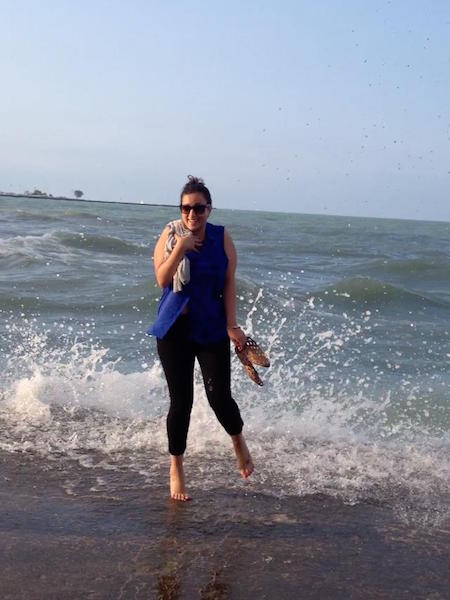
I finally felt like the successful 26-year-old woman I was. On my return in 2012, I secured a promotion, my social life flourished and I started a very happy relationship.
Months on, the endometriosis was back, and the GP gave me tramadol. I had surgery twice more over the ensuing year.
When I came off the meds, the usual ‘flu’ hit. But this third time, there was something else.
…and then the crippling anxiety
When my previous relationship had broken down, around the time of my endometriosis diagnosis in November 2011, I’d moved back in with my mum.
I’d been dating someone new, Andy for 11 months when we rented a flat together in September 2013 (we’re now married).
But the night before I moved in with Andy, I had anxiety so intense, my limbs were twitching. It wasn’t about him – Andy was kind and supportive and by my side through the last two ops. It was something else.
I crawled into my mum’s bed that night, genuinely scared I was going to die.
In the grip of that impending doom and panic, I Googled my symptoms.
Anxiety, twitching limbs, symptoms of flu.
As the results loaded, my world tipped on its axis.
I wasn’t suffering ‘flu’, but opiate withdrawal – the type you see on TV when a drug addict curls up in a corner while going ‘cold turkey’.
The shame of realising the truth
Shame swept over me as I realised whilst managing my pain, every cell in my body had become dependent on opiates.
In the past, I’d ditched friends who took drugs on nights out. I’d looked down my coke-free nose at them, judged them. How did I now have a drug problem?
The side effects I’d experienced when I’d started the pills – drowsiness, skin sensitivity, being emotionally numb, loss of appetite, constipation and inability to concentrate – were now brutally reversing.
I had insomnia, skin numbness, nausea, diarrhoea, anxiety and time warped like that scene in Bradley Cooper’s Limitless, when his character’s drug-fuelled mind is moving at warp speed through New York.
That night, 26, living at home and addicted to painkillers, I clutched my mother’s hand trapped somewhere between delirium and night terrors of flames and buildings tipping over.
The next day, Andy and I moved in together. Overnight, I’d felt so rough with the detox that I’d wondered if I should just delay our move, but we’d looked forward to it for months and I’d spent weeks buying everything for our flat. I wasn’t prepared to let that go.
Mum was sympathetic but I didn’t tell her the full extent of what was happening, fearful she’d talk me into delaying the move. I didn’t tell Andy the extent either, and I guess, I didn’t really realise how long it would go on for or how hard things would continue to be.
I tested my withdrawal theory by taking a dose of tramadol and within an hour, my symptoms disappeared – my body and mind restored. I knew then I was in serious trouble.

The drug felt impossible to stop
My GP told me to resume my usual doses and cut down over two weeks. I tried that, but once I got to the last tablet, the withdrawal came back full force. I tried again over six weeks with the same result.
I had to push through. Normality was just one tablet away, so I filled a bag with my pills and binned the lot.
I threw myself into work, commissioning the mag during the day, ghostwriting books for Penguin at night. My pain remained so I worked with a heat pad on my front and an ice pack on my back, both in the office and at home.
I was known for being organised, efficient, highly-skilled and dedicated. I wasn’t prepared to let that image slip.
I didn’t tell anybody in the office what was happening. I played it down to Andy and my parents, saying I was experiencing some normal withdrawal symptoms, but was weaning off gradually. No big deal.
Mum had always joked about wanting me to be little again and climb into her bed and hold her hand while I slept. She thought it was my final hurrah before moving out.
But I told Andy I thought this is withdrawal, but neither of us really understood the magnitude of what was happening to me.
I was scared to be labelled a drug addict or be denied access to proper pain relief.
I talked to opiate dependants/addicts in internet forums and snuck out of bed to watch TV through sleepless nights.
I survived on a couple of hours of sleep, coffee and chocolate, then spent evenings obsessively cleaning our flat, cooking or writing. Keeping my hands busy helped the anxiety and twitchy limbs.
Somewhere over six weeks, withdrawal faded.
Next time I needed surgery, I refused tramadol and was given codeine and morphine to take home. I stopped the morphine after a few days, scared of addiction, but the codeine was put on repeat.
The side effects were much milder and I hoped the withdrawal later would be mild too. It wasn’t.
The GP had nothing to offer sending me away to cope alone.
Clean for two years
For two years, I didn’t touch a single painkiller as we tried for a baby, then had IVF. My pelvic pain during this period was horrific. Even in pregnancy, it was awful, and I was in a wheelchair by the end.
Punteha pregnant in August, 2016. Photo credits: www.vtfeatures.co.uk
Before I fell pregnant, I pushed through the pain for weeks until it faded, throwing myself into work. It did help that I was having weekly Cognitive Behavioural Therapy (CBT) at the time to deal with all my anxiety and sadness about our infertility and continuing inability to have a baby. I used the mindfulness and body scanning techniques I learned to help me with my withdrawal anxiety and insomnia.
Eventually our miracle daughter Amelia arrived on September 25th, 2016, and I was ecstatic. But during maternity leave, I needed surgery twice to repair hip cartilage that’d ripped in pregnancy. It felt like I was doomed.
I left my job, in favour of flexible hours and being my own boss as a freelancer.
Withdrawal…number five
By June 2013, I was in the grip of my fifth withdrawal. I felt like an expert now. I knew exactly what to expect, how long it would last, when the peak would be and how much longer each stage would go on for. Knowing what was going to happen to me was good and bad; like knowing you’re about to crash your car and break your bones in the process, know awful and painful it’s going to be but still remain unable to change the course of it.
You’re probably wondering why I never went to rehab. But that would mean I seriously had a problem with drugs and I couldn’t and wouldn’t label myself in such a way. I was also scared that my endometriosis pain would continue and then, labelled a drug addict, I would be denied proper pain relief in the future. I reasoned that it was better to go it alone, than be labelled and then denied help controlling my pain.
The turning point towards recovery
Around the same time, I wrote a feature about the opiate crisis for a Sunday newspaper and interviewed another addict, a married mum who’d also held down a full-time job through decades of addiction.
She’d been sober for six years having detoxed in a residential clinic over a number of months with the full support of a medical team of addiction experts.
I confided in her and she gave me some life-changing advice. I couldn’t stop my withdrawal, but I could manage the symptoms instead.
I started Imodium for diarrhoea and cramps, ginger biscuits for nausea, valerian root tea for anxiety and insomnia, and regular doses of paracetamol and ibuprofen for aches and fever.
It took the edge off – a little. Detoxing was still torture, so I told close friends and relatives I was going through it, finally shaking off the stigma that comes with addiction/dependency.
Andy and mum were both shocked, sad and supportive, and urged me to keep confiding in them. I was too anxious to talk on the phone, so mum would WhatsApp me for hours and hours, talking to me through the night.
Andy listened all evening, at home and checked on me during the day. My extended family were all casual and understanding about it. Not making a big deal, but making me feel like it’s okay to just tell them about it. I didn’t have to suffer in silence and alone anymore.
I also stopped blaming myself. I had a painful disease. I didn’t have to punish myself by suffering in secret through withdrawal from drugs I’d needed to survive that pain.
At last, I acknowledged addiction and withdrawal are a big deal – a physical and mental ordeal, actually.
I gave myself a week off. Maybe two. I don’t remember, it passed in a blur. Sometimes, I’d cry from the hopelessness I felt. But the majority of that withdrawal was over within three weeks, then life resumed with a bit of normality. I had Millie at home again from nursery on Wednesdays (I’d put her in for an extra day while I went through worst of withdrawal), I started cooking, cleaning and going out again.
When Andy and Amelia were home, it tore my heart in two hearing her calling for me at the bottom of the stairs, and not having the energy to go to her.
Andy texted video updates from downstairs to make me feel included, but Millie’s beautiful face made me feel like a failure, as a mum and wife.
Andy took care of Amelia and me. It was a short-term sacrifice for long-term gain.
For the first time, I permitted myself time off from the world to get through the horror of it.
Three months ago, at 32, I had my left ovary removed and a lot of disease cut out in what I hope was my last endo op. My surgeon remarked on what a painful mess it was in there afterwards, adding ‘I don’t know how you’ve survived this.’
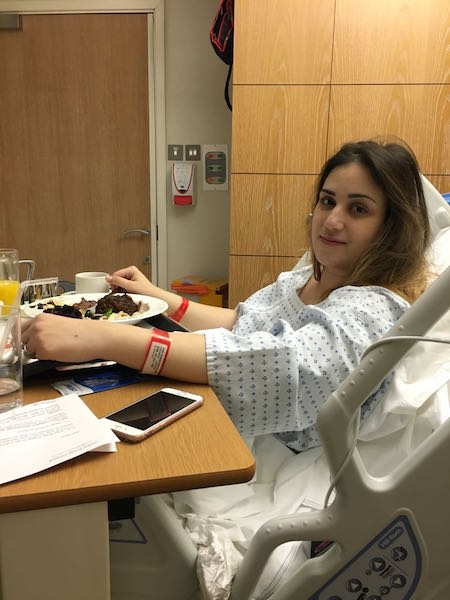
I don’t either. Sheer bloody mindedness? Determination to protect my career? My family?
I’m now on hormones to suppress my periods and absolutely no more opiates.
On and off, I was addicted to painkillers for nine years and I would be lying if I said I didn’t crave them still. But knowing I don’t need the pain relief anymore and that I never, ever, want to go through withdrawal again keeps me off.
I’ve since set up an anonymous Twitter account where I’ve connected to lots of other opiate addicts/dependents trying to live a sober life and we seek support from each other – you’d be surprised how many normal, fully functioning, worthy members of our society have anonymous accounts just like mine to help them stay off prescription opiates.
Feeling better than ever
I’m feeling better than I have in years, finally able to walk more than a few paces, sit without intense pain and do simple things, like go to Tesco on my own.
I still have bad days, but my body is no longer restrictive, forcing me to choose between showering or cooking, taking Amelia to the park or doing the dishes, celebrating my birthday or spending a week in bed recovering.
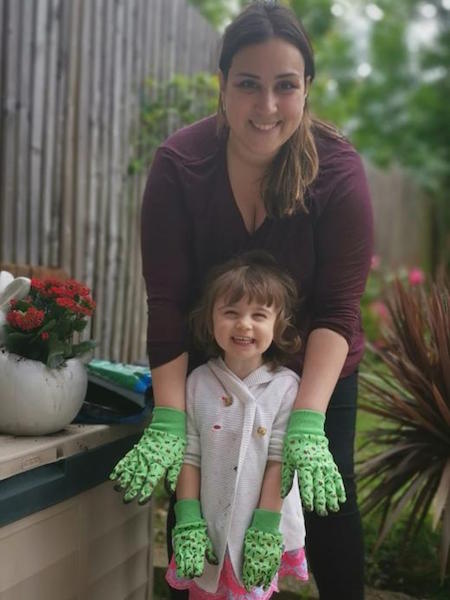
It’s been eight weeks since my last codeine, and I’m through the worst of what I hope is my final ever detox – six weeks that felt as awful as ever, with the anxiety particularly debilitating.
But my journey through pain, no diagnosis, multiple operations and opiate withdrawals has taken a huge toll on my emotional wellbeing.
I have ongoing anxiety and if I am very honest with myself, depression. A kindly GP friend tells me that’s likely due to the chemical changes withdrawal is having on my brain.
This means that whilst the physical withdrawal symptoms in my body will fade away, my brain will remain in withdrawal for six months or more, causing anxiety or depression, or both.
Overtime this will fix itself, I’m told. In fact, last week I went to the doctor and started paroxetine, an SSRI anti-depressant as my anxiety was at unbearable levels, leaving me unable to get out of bed. It’s the price I have been forced to pay and I’m happy with that.
The anxiety may linger for months, but I’ll take it.
The darkness has passed, and dawn has finally broken. I am hopeful that by autumn; life will be the best it’s ever been.
8 signs you may be addicted to opiates
*this list is not exhaustive and should only be used for guidance
- Tendency to visit doctors frequently, or shop online for prescription drugs
- Regular complaints about medical conditions that would justify drug use
- A gradual drop-off in school or work performance, and increasing disinterest in personal appearance
- A tendency toward defensiveness when talking about prescription medications
- Noticeable mood swings based on the availability of drug supplies
- Increasing irritability and anxiousness – also linked to drug availability
- Interrupted sleep patterns – can include long-term insomnia
- Increased alcohol consumption between episodes of drug use
Eytan Alexander, managing director of addiction treatment firm, UKAT adds, ‘opioid prescription drug addiction can affect anyone. It can happen to the rich, the poor, men and women, anyone from any walk of life.
Ultimately, if an individual is abusing their prescription drugs, they have a problem and should seek professional support.
Speaking with your GP is a good starting point for change, and even though they are the ones issuing the prescriptions, it’s important to stress you are ready to slowly taper off the drugs and tackle whatever pain or issues that were being masked with the drugs.
Alternative opioid-free pain therapies like yoga, acupuncture, physiotherapy, a changed diet and non-opioid pain relief like paracetamol are good options.’
For more information, visit ukat.co.uk/prescription-drug-addiction
More Healthista Content:
Body transformation week 8 – The ONLY gym moves you need for serious fat loss
Got a pimple down there? When to worry and what to do
12 adult acne questions answered by this doctor who had it herself
This woman had an EYELASH transplant
Like this article? Sign up to our newsletter to get more articles like this delivered straight to your inbox.



